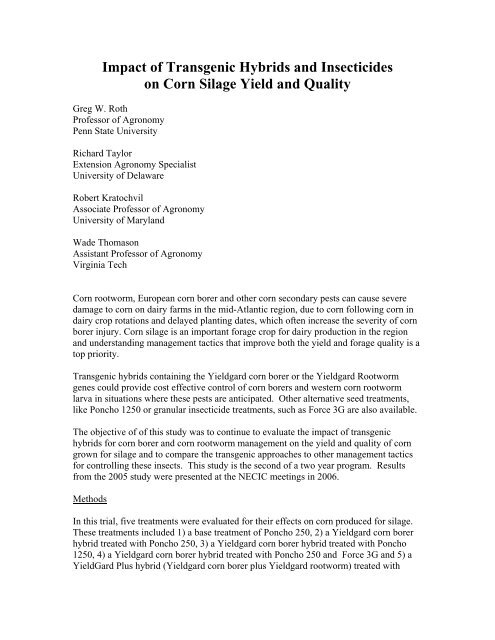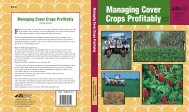Impact of Transgenic Hybrids and Insecticides on Corn Silage Yield ...
Impact of Transgenic Hybrids and Insecticides on Corn Silage Yield ...
Impact of Transgenic Hybrids and Insecticides on Corn Silage Yield ...
You also want an ePaper? Increase the reach of your titles
YUMPU automatically turns print PDFs into web optimized ePapers that Google loves.
<str<strong>on</strong>g>Impact</str<strong>on</strong>g> <str<strong>on</strong>g>of</str<strong>on</strong>g> <str<strong>on</strong>g>Transgenic</str<strong>on</strong>g> <str<strong>on</strong>g>Hybrids</str<strong>on</strong>g> <str<strong>on</strong>g>and</str<strong>on</strong>g> <str<strong>on</strong>g>Insecticides</str<strong>on</strong>g><br />
<strong>on</strong> <strong>Corn</strong> <strong>Silage</strong> <strong>Yield</strong> <str<strong>on</strong>g>and</str<strong>on</strong>g> Quality<br />
Greg W. Roth<br />
Pr<str<strong>on</strong>g>of</str<strong>on</strong>g>essor <str<strong>on</strong>g>of</str<strong>on</strong>g> Agr<strong>on</strong>omy<br />
Penn State University<br />
Richard Taylor<br />
Extensi<strong>on</strong> Agr<strong>on</strong>omy Specialist<br />
University <str<strong>on</strong>g>of</str<strong>on</strong>g> Delaware<br />
Robert Kratochvil<br />
Associate Pr<str<strong>on</strong>g>of</str<strong>on</strong>g>essor <str<strong>on</strong>g>of</str<strong>on</strong>g> Agr<strong>on</strong>omy<br />
University <str<strong>on</strong>g>of</str<strong>on</strong>g> Maryl<str<strong>on</strong>g>and</str<strong>on</strong>g><br />
Wade Thomas<strong>on</strong><br />
Assistant Pr<str<strong>on</strong>g>of</str<strong>on</strong>g>essor <str<strong>on</strong>g>of</str<strong>on</strong>g> Agr<strong>on</strong>omy<br />
Virginia Tech<br />
<strong>Corn</strong> rootworm, European corn borer <str<strong>on</strong>g>and</str<strong>on</strong>g> other corn sec<strong>on</strong>dary pests can cause severe<br />
damage to corn <strong>on</strong> dairy farms in the mid-Atlantic regi<strong>on</strong>, due to corn following corn in<br />
dairy crop rotati<strong>on</strong>s <str<strong>on</strong>g>and</str<strong>on</strong>g> delayed planting dates, which <str<strong>on</strong>g>of</str<strong>on</strong>g>ten increase the severity <str<strong>on</strong>g>of</str<strong>on</strong>g> corn<br />
borer injury. <strong>Corn</strong> silage is an important forage crop for dairy producti<strong>on</strong> in the regi<strong>on</strong><br />
<str<strong>on</strong>g>and</str<strong>on</strong>g> underst<str<strong>on</strong>g>and</str<strong>on</strong>g>ing management tactics that improve both the yield <str<strong>on</strong>g>and</str<strong>on</strong>g> forage quality is a<br />
top priority.<br />
<str<strong>on</strong>g>Transgenic</str<strong>on</strong>g> hybrids c<strong>on</strong>taining the <strong>Yield</strong>gard corn borer or the <strong>Yield</strong>gard Rootworm<br />
genes could provide cost effective c<strong>on</strong>trol <str<strong>on</strong>g>of</str<strong>on</strong>g> corn borers <str<strong>on</strong>g>and</str<strong>on</strong>g> western corn rootworm<br />
larva in situati<strong>on</strong>s where these pests are anticipated. Other alternative seed treatments,<br />
like P<strong>on</strong>cho 1250 or granular insecticide treatments, such as Force 3G are also available.<br />
The objective <str<strong>on</strong>g>of</str<strong>on</strong>g> <str<strong>on</strong>g>of</str<strong>on</strong>g> this study was to c<strong>on</strong>tinue to evaluate the impact <str<strong>on</strong>g>of</str<strong>on</strong>g> transgenic<br />
hybrids for corn borer <str<strong>on</strong>g>and</str<strong>on</strong>g> corn rootworm management <strong>on</strong> the yield <str<strong>on</strong>g>and</str<strong>on</strong>g> quality <str<strong>on</strong>g>of</str<strong>on</strong>g> corn<br />
grown for silage <str<strong>on</strong>g>and</str<strong>on</strong>g> to compare the transgenic approaches to other management tactics<br />
for c<strong>on</strong>trolling these insects. This study is the sec<strong>on</strong>d <str<strong>on</strong>g>of</str<strong>on</strong>g> a two year program. Results<br />
from the 2005 study were presented at the NECIC meetings in 2006.<br />
Methods<br />
In this trial, five treatments were evaluated for their effects <strong>on</strong> corn produced for silage.<br />
These treatments included 1) a base treatment <str<strong>on</strong>g>of</str<strong>on</strong>g> P<strong>on</strong>cho 250, 2) a <strong>Yield</strong>gard corn borer<br />
hybrid treated with P<strong>on</strong>cho 250, 3) a <strong>Yield</strong>gard corn borer hybrid treated with P<strong>on</strong>cho<br />
1250, 4) a <strong>Yield</strong>gard corn borer hybrid treated with P<strong>on</strong>cho 250 <str<strong>on</strong>g>and</str<strong>on</strong>g> Force 3G <str<strong>on</strong>g>and</str<strong>on</strong>g> 5) a<br />
<strong>Yield</strong>Gard Plus hybrid (<strong>Yield</strong>gard corn borer plus <strong>Yield</strong>gard rootworm) treated with
P<strong>on</strong>cho 250. All hybrids were Roundup Ready. Three different sets <str<strong>on</strong>g>of</str<strong>on</strong>g> base genetics<br />
were used in this study: these were provided by <strong>Corn</strong> States <str<strong>on</strong>g>and</str<strong>on</strong>g> represent adapted<br />
commercial hybrids used in the regi<strong>on</strong>.<br />
<strong>Corn</strong> was planted in mid May at each locati<strong>on</strong> following corn at locati<strong>on</strong>s near Rock<br />
Springs, PA, Newark, DE, Keedysville, MD <str<strong>on</strong>g>and</str<strong>on</strong>g> Harris<strong>on</strong>burg, VA. Each treatment was<br />
replicated four times <str<strong>on</strong>g>and</str<strong>on</strong>g> the individual plot size was 4 rows (10 feet) <str<strong>on</strong>g>and</str<strong>on</strong>g> 25 feet l<strong>on</strong>g.<br />
Problems at the Harris<strong>on</strong>burg site with silage quality evaluati<strong>on</strong> caused us to discard the<br />
data from this locati<strong>on</strong>.<br />
Root ratings were made from 5 root samples dug from two replicati<strong>on</strong>s in each treatment.<br />
These ratings were made using the Iowa State 0-3 scale. From each check plot<br />
(Treatment #1) root ratings were obtained after tasseling. Height was measured to the<br />
collar <str<strong>on</strong>g>of</str<strong>on</strong>g> the last leaf at the Pennsylvania locati<strong>on</strong>.<br />
For both trials at harvest, yield data was collected by harvesting a single row from the<br />
interior <str<strong>on</strong>g>of</str<strong>on</strong>g> each plot with a two row silage plot chopper at the Pennsylvania locati<strong>on</strong> <str<strong>on</strong>g>and</str<strong>on</strong>g><br />
by h<str<strong>on</strong>g>and</str<strong>on</strong>g> at the other two locati<strong>on</strong>. Forage obtained was weighed in the field <str<strong>on</strong>g>and</str<strong>on</strong>g> a<br />
subsample was collected from the harvested material. Where the plots were harvested by<br />
h<str<strong>on</strong>g>and</str<strong>on</strong>g> the sample c<strong>on</strong>sisted <str<strong>on</strong>g>of</str<strong>on</strong>g> five r<str<strong>on</strong>g>and</str<strong>on</strong>g>om plants, which were chopped <strong>on</strong> site <str<strong>on</strong>g>and</str<strong>on</strong>g><br />
subsampled. These subsamples were sent to Dairy One, Inc., Ithaca, NY for forage<br />
quality <str<strong>on</strong>g>and</str<strong>on</strong>g> dry matter analysis. The weight <str<strong>on</strong>g>and</str<strong>on</strong>g> moisture were then used to calculate the<br />
yields. Milk per acre <str<strong>on</strong>g>and</str<strong>on</strong>g> milk/t<strong>on</strong> were calculated using the Milk 2000 program<br />
Data were analyzed using SAS 8.0 in a factorial analysis averaging effects over hybrids<br />
<str<strong>on</strong>g>and</str<strong>on</strong>g> treatments at individual sites. Least significant differences were calculated for those<br />
measurements where significant differences occurred.<br />
Results<br />
<strong>Yield</strong>s at each locati<strong>on</strong> were good, despite the sporadic rainfall <str<strong>on</strong>g>and</str<strong>on</strong>g> heat at all locati<strong>on</strong>s.<br />
European corn borer pressure was significant at each <str<strong>on</strong>g>of</str<strong>on</strong>g> the three locati<strong>on</strong>s but much less<br />
than in 2005, when infestati<strong>on</strong>s averaged 2.7 tunnels per plant. European corn borer<br />
tunnels/stalk in the n<strong>on</strong>-Bt check plots averaged 1.1, 0.8 <str<strong>on</strong>g>and</str<strong>on</strong>g> 0.8 for the Delaware,<br />
Maryl<str<strong>on</strong>g>and</str<strong>on</strong>g> <str<strong>on</strong>g>and</str<strong>on</strong>g> Pennsylvania locati<strong>on</strong>s respectively. <strong>Corn</strong> rootworm ratings (0-3 rating<br />
system) were generally similar to 2005 <str<strong>on</strong>g>and</str<strong>on</strong>g> averaged 0.3, 0.1 <str<strong>on</strong>g>and</str<strong>on</strong>g> 0.1.0 at the Delaware,<br />
Maryl<str<strong>on</strong>g>and</str<strong>on</strong>g> <str<strong>on</strong>g>and</str<strong>on</strong>g> Pennsylvania locati<strong>on</strong>s respectively.<br />
Resp<strong>on</strong>ses to the insecticide treatments were significant <strong>on</strong>ly at the Pennsylvania<br />
locati<strong>on</strong>, although similar resp<strong>on</strong>se trends existed at the two locati<strong>on</strong>s. In general,<br />
hybridxtrait interacti<strong>on</strong>s were not significant for yield <str<strong>on</strong>g>and</str<strong>on</strong>g> most forage quality traits.<br />
The yield resp<strong>on</strong>se relative to the check (treatment 5) from the additi<strong>on</strong> <str<strong>on</strong>g>of</str<strong>on</strong>g> the YGCB trait<br />
(treatment 4), averaged 1.4 t<strong>on</strong>s/acre <str<strong>on</strong>g>and</str<strong>on</strong>g> was likely due to the c<strong>on</strong>sistent corn borer<br />
pressure at each site. This yield resp<strong>on</strong>se was less than 2.7 t<strong>on</strong>s/acre measured in 2005<br />
<str<strong>on</strong>g>and</str<strong>on</strong>g> is c<strong>on</strong>sistent with some <str<strong>on</strong>g>of</str<strong>on</strong>g> our previous studies that have shown good resp<strong>on</strong>se to
corn borer c<strong>on</strong>trol when planting date is delayed. Previous studies have shown that yield<br />
increases <str<strong>on</strong>g>of</str<strong>on</strong>g> approximately 2.5%/tunnel can be anticipated. In this study, we averaged<br />
0.9 tunnels per plant across all three locati<strong>on</strong>s which would result in a 6.2% silage yield<br />
increase per tunnel. This was c<strong>on</strong>sistent with the 4.2% increase shown in 2005 <str<strong>on</strong>g>and</str<strong>on</strong>g> both<br />
years the yield resp<strong>on</strong>se was higher than the 2.5%/tunnel resp<strong>on</strong>se reported in previous<br />
grain studies. No significant differences were noted in the forage quality due to the<br />
additi<strong>on</strong> <str<strong>on</strong>g>of</str<strong>on</strong>g> the YGCB gene.<br />
Differences am<strong>on</strong>g the rootworm c<strong>on</strong>trol tactics, which all c<strong>on</strong>tained the YGCB gene,<br />
<str<strong>on</strong>g>and</str<strong>on</strong>g> the rootworm check (treatment 4) were less pr<strong>on</strong>ounced in 2006 compared to 2005.<br />
Averaged over all locati<strong>on</strong>s the yield <str<strong>on</strong>g>of</str<strong>on</strong>g> the Force treatment was similar to that <str<strong>on</strong>g>of</str<strong>on</strong>g> the<br />
YGPL treatment. We did not observe the lower yields associated with Force compared to<br />
the <strong>Yield</strong>gard Plus treatment that we observed in 2005. The <strong>Yield</strong>gard Plus <str<strong>on</strong>g>and</str<strong>on</strong>g> Force<br />
treatments averaged 26.5 t<strong>on</strong>s/acre, while the P<strong>on</strong>cho 1250 treatment averaged 25.7<br />
t<strong>on</strong>s/acre <str<strong>on</strong>g>and</str<strong>on</strong>g> the check treatment without any rootworm or corn borer c<strong>on</strong>trol averaged<br />
24.8 t<strong>on</strong>s/acre.<br />
No trends in forage quality differences were noted am<strong>on</strong>g the rootworm c<strong>on</strong>trol<br />
treatments, probably due to the lack <str<strong>on</strong>g>of</str<strong>on</strong>g> rootworm stress <strong>on</strong> the corn. This data also<br />
c<strong>on</strong>firms for the sec<strong>on</strong>d year that the additi<strong>on</strong> <str<strong>on</strong>g>of</str<strong>on</strong>g> the YGRW gene has no negative impact<br />
<strong>on</strong> the forage quality <str<strong>on</strong>g>of</str<strong>on</strong>g> the corn when used for silage.<br />
In 2006, we also measured levels <str<strong>on</strong>g>of</str<strong>on</strong>g> five mycotoxins (aflatoxin, vomitoxin, zearalan<strong>on</strong>e,<br />
T2 <str<strong>on</strong>g>and</str<strong>on</strong>g> fum<strong>on</strong>isin) in all <str<strong>on</strong>g>of</str<strong>on</strong>g> the <strong>Yield</strong>gard Plus treatments <str<strong>on</strong>g>and</str<strong>on</strong>g> the check RR treatments.<br />
Our analysis showed relatively low levels <str<strong>on</strong>g>of</str<strong>on</strong>g> mycotoxins, <str<strong>on</strong>g>and</str<strong>on</strong>g> <strong>on</strong>ly two instances <str<strong>on</strong>g>of</str<strong>on</strong>g><br />
significant effects due to the insect c<strong>on</strong>trol genes. One was at the Pennsylvania site,<br />
where vomitoxin levels averaged about 0.8 ppm <str<strong>on</strong>g>and</str<strong>on</strong>g> were significantly lower with the RR<br />
hybrid. There were significant differences am<strong>on</strong>g hybrids at this site also <str<strong>on</strong>g>and</str<strong>on</strong>g> for <strong>on</strong>e<br />
hybrid, hybrid C, which was much higher than the other two hybrids. For this hybrid, the<br />
c<strong>on</strong>trol averaged 2.3 ppm vomitoxin <str<strong>on</strong>g>and</str<strong>on</strong>g> the <strong>Yield</strong>Gard Plus event averaged 0.6 pm. For<br />
the other two hybrids, differences were negligible. At Delaware, <strong>on</strong>e hybrid showed a<br />
difference in aflatoxin for <strong>on</strong>e hybrid between the <strong>Yield</strong>gard Plus <str<strong>on</strong>g>and</str<strong>on</strong>g> the c<strong>on</strong>trol. In this<br />
case the <strong>Yield</strong>Gard Plus hybrid had aflatoxin levels <str<strong>on</strong>g>of</str<strong>on</strong>g> 3.3 ppb compared to 1.0 for the<br />
c<strong>on</strong>trol.<br />
In summary, our results c<strong>on</strong>firmed most <str<strong>on</strong>g>of</str<strong>on</strong>g> what we found in 2005. The transgenic corn<br />
borer <str<strong>on</strong>g>and</str<strong>on</strong>g> rootworm traits can provide some benefits in yield in some envir<strong>on</strong>ments.<br />
Forage quality effects from these traits were small. Effects <strong>on</strong> mycotoxins were<br />
relatively inc<strong>on</strong>sistent <str<strong>on</strong>g>and</str<strong>on</strong>g> hybrid specific.
















